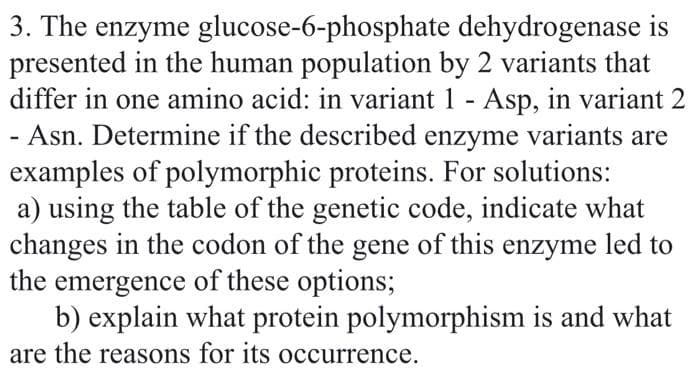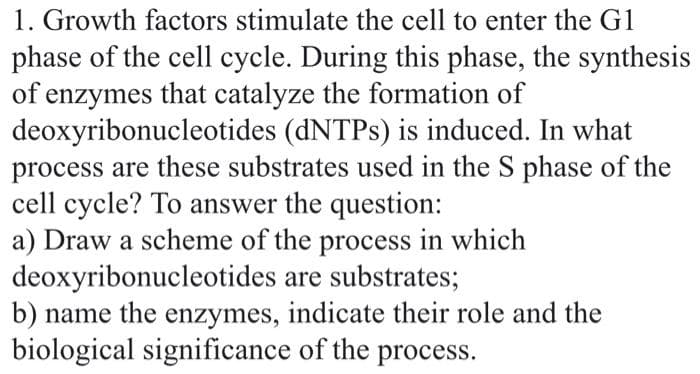3. The enzyme glucose-6-phosphate dehydrogenase is presented in the human population by 2 variants that differ in one amino acid: in variant 1 Asp, in variant 2 - Asn. Determine if the described enzyme variants are examples of polymorphic proteins. For solutions: a) using the table of the genetic code, indicate what changes in the codon of the gene of this enzyme led to the emergence of these options; b) explain what protein polymorphism is and what are the reasons for its occurrence.
3. The enzyme glucose-6-phosphate dehydrogenase is presented in the human population by 2 variants that differ in one amino acid: in variant 1 Asp, in variant 2 - Asn. Determine if the described enzyme variants are examples of polymorphic proteins. For solutions: a) using the table of the genetic code, indicate what changes in the codon of the gene of this enzyme led to the emergence of these options; b) explain what protein polymorphism is and what are the reasons for its occurrence.
Biology: The Dynamic Science (MindTap Course List)
4th Edition
ISBN:9781305389892
Author:Peter J. Russell, Paul E. Hertz, Beverly McMillan
Publisher:Peter J. Russell, Paul E. Hertz, Beverly McMillan
Chapter10: Cell Division And Mitosis
Section: Chapter Questions
Problem 1ITD: Biologists have long been interested in the effects of radiation on cells. In one experiment,...
Related questions
Question

Transcribed Image Text:3. The enzyme glucose-6-phosphate dehydrogenase is
presented in the human population by 2 variants that
differ in one amino acid: in variant 1 - Asp, in variant 2
- Asn. Determine if the described enzyme variants are
examples of polymorphic proteins. For solutions:
a) using the table of the genetic code, indicate what
changes in the codon of the gene of this enzyme led to
the emergence of these options;
b) explain what protein polymorphism is and what
are the reasons for its occurrence.

Transcribed Image Text:1. Growth factors stimulate the cell to enter the G1
phase of the cell cycle. During this phase, the synthesis
of enzymes that catalyze the formation of
deoxyribonucleotides (dNTPs) is induced. In what
process are these substrates used in the S phase of the
cell cycle? To answer the question:
a) Draw a scheme of the process in which
deoxyribonucleotides are substrates;
b) name the enzymes, indicate their role and the
biological significance of the process.
Expert Solution
This question has been solved!
Explore an expertly crafted, step-by-step solution for a thorough understanding of key concepts.
Step by step
Solved in 2 steps

Knowledge Booster
Learn more about
Need a deep-dive on the concept behind this application? Look no further. Learn more about this topic, biology and related others by exploring similar questions and additional content below.Recommended textbooks for you

Biology: The Dynamic Science (MindTap Course List)
Biology
ISBN:
9781305389892
Author:
Peter J. Russell, Paul E. Hertz, Beverly McMillan
Publisher:
Cengage Learning

Biochemistry
Biochemistry
ISBN:
9781305577206
Author:
Reginald H. Garrett, Charles M. Grisham
Publisher:
Cengage Learning

Biology: The Dynamic Science (MindTap Course List)
Biology
ISBN:
9781305389892
Author:
Peter J. Russell, Paul E. Hertz, Beverly McMillan
Publisher:
Cengage Learning

Biochemistry
Biochemistry
ISBN:
9781305577206
Author:
Reginald H. Garrett, Charles M. Grisham
Publisher:
Cengage Learning